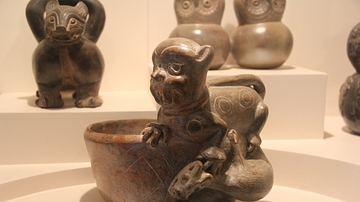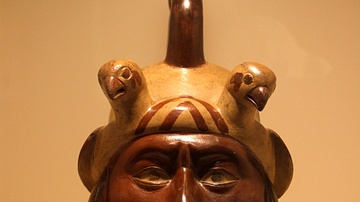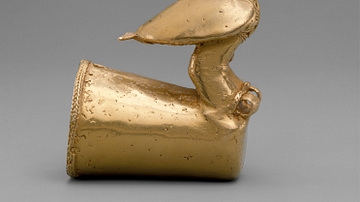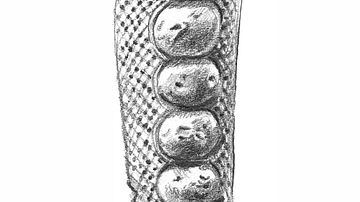Search
Search Results

Image
Cupisnique Culture Sacred Animals
This piece shows a feline, owl, serpents, and condor. The owl and condor represented the sky while the feline represented the earth and dominance. The serpent represented the subterranean world. Housed in the Museo Larco, Lima, Peru.

Image
Portrait Vessel, Moche Culture
This portrait vessel was made during the Moche civilization's Apogee Epoch (c. 1 CE - 800 CE). House in Museo Larco, Lima, Peru.

Quiz
Arts and Culture in Ancient Greece
Aesychlus Aristophanes Base Capital Chorus Comedy Corinthian column Dionysus Doric column Drama Entablature Entasis Euripides Frieze Ionic column Metope Pediment Philosophy Satyr play Shaft Skene Sophocles Tragedy Triglyph Socrates Plato...

Image
Painted Bowl from Halaf Culture
This painted bowl dates back to the Halaf period, Mesopotamia, sixth century BCE. (The Sulaimaniya Museum, Iraq).

Image
Gold Staff Finial, Zenu Culture
A gold staff finial made by the Zenúes, a people who belonged to the Zenú tribe of ancient Colombia. It features an owl on the edge with a majestic crest, polished golden wings and false filigree openwork on its chest. Distinctive features...

Image
Kikimora in Popular Culture
Henry Cavill in The Witcher (2019) by Netflix.
The image portrays a modern reimagination of Slavic Kikimora.
© Netflix

Image
Gandao in Kalasha culture
Gandao is the wooden image aimed at immortalizing the important departed souls of the Kalasha family member. Gandao is installed at cemetery. The Kalasha is sole pagan tribe of Pakistan with numerical strength of 4000 approx. The Kalasha...

Image
Carved Globule Bones (Castelluccio Culture, Sicily)
Animal bone segments (early bronze age, c. 2169 - c. 1500 BCE), between 13-15 centimeters in length, sometimes decorated with incisions on which, successively, have been carried out globules in relief. Their uses are not yet known, although...

Image Gallery
A Gallery of 20 Mummies from around the World
Mummification is the natural or artificial preservation of the soft tissue of a dead body. Natural mummification can happen in extremely cold, dry, or anaerobic conditions. Perhaps the most famous example of a natural mummy preserved in ice...

Video
History of the Etruscan Culture: the First Great Italian Civilization
The Etruscans, who knew themselves as the Rasenna, were a culture that flourished in central Italy in the region of Etruria between the 8th and the 3rd century BCE. They are first mentioned by the Greek writer Hesiod in the 8th century BCE...